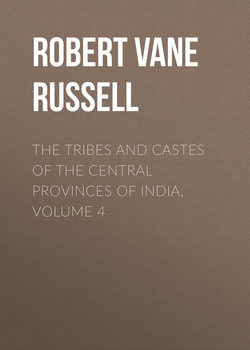Читать книгу The Tribes and Castes of the Central Provinces of India, Volume 4 - Robert Vane Russell - Страница 2
Part II
Articles on Castes and Tribes
Kumhār—Yemkala
Vol. IV
Kumhār
1. Traditions of origin
ОглавлениеKumhār, Kumbhār.—The caste of potters, the name being derived from the Sanskrit kumbh, a water-pot. The Kumhārs numbered nearly 120,000 persons in the Central Provinces in 1911 and were most numerous in the northern and eastern or Hindustāni-speaking Districts, where earthen vessels have a greater vogue than in the south. The caste is of course an ancient one, vessels of earthenware having probably been in use at a very early period, and the old Hindu scriptures consequently give various accounts of its origin from mixed marriages between the four classical castes. “Concerning the traditional parentage of the caste,” Sir H. Risley writes,1 “there seems to be a wide difference of opinion among the recognised authorities on the subject. Thus the Brahma Vaivārtta Purāna says that the Kumbhakār or maker of water-jars (kumbka), is born of a Vaishya woman by a Brāhman father; the Parāsara Samhita makes the father a Mālākār (gardener) and the mother a Chamār; while the Parāsara Padhati holds that the ancestor of the caste was begotten of a Tili woman by a Pattikār or weaver of silk cloth.” Sir Monier Williams again, in his Sanskrit Dictionary, describes them as the offspring of a Kshatriya woman by a Brāhman. No importance can of course be attached to such statements as the above from the point of view of actual fact, but they are interesting as showing the view taken of the formation of castes by the old Brāhman writers, and also the position given to the Kumhār at the time when they wrote. This varies from a moderately respectable to a very humble one according to the different accounts of his lineage. The caste themselves have a legend of the usual Brāhmanical type: “In the Kritayuga, when Maheshwar (Siva) intended to marry the daughter of Hemvanta, the Devas and Asuras2 assembled at Kailās (Heaven). Then a question arose as to who should furnish the vessels required for the ceremony, and one Kulālaka, a Brāhman, was ordered to make them. Then Kulālaka stood before the assembly with folded hands, and prayed that materials might be given to him for making the pots. So Vishnu gave his Sudarsana (discus) to be used as a wheel, and the mountain of Mandāra was fixed as a pivot beneath it to hold it up. The scraper was Adi Kūrma the tortoise, and a rain-cloud was used for the water-tub. So Kulālaka made the pots and gave them to Maheshwar for his marriage, and ever since his descendants have been known as Kumbhakār or maker of water-jars.”
Potter and his wheel
1
Tribes and Castes of Bengal, art. Kumhār.
2
Gods and demons.
